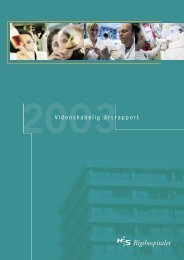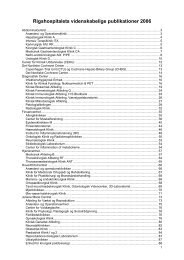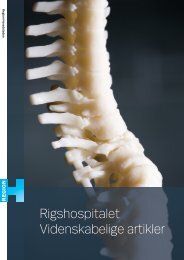View - CTU
View - CTU
View - CTU
Create successful ePaper yourself
Turn your PDF publications into a flip-book with our unique Google optimized e-Paper software.
Bj¢rndal & Reit Endodontic treatments in DK<br />
Endodontic treatm<br />
probably reflects that the old procedure of treating the<br />
curved root in a multi-rooted tooth with pulpotomy has<br />
become regarded as obsolete by the practitioners.<br />
Instead, the full canal is being instrumented and<br />
obturated.<br />
Rather low frequencies of pulp capping and stepwise<br />
excavation were recorded. Studies have shown that<br />
both treatment methods can be applied with a good<br />
prognosis (Horsted et al. 1985, Bjorndal 2002). The<br />
infrequent use among Danish dentists might be due to a<br />
preference for a more extensive pulp therapy, such as<br />
pulpectomy. However, it might also be a reflection of<br />
low caries prevalence in the population. The overall<br />
decline in the prevalence of caries can be understood as<br />
a reduced rate of disease progression (Thylstrup &<br />
Birkeland 1994). In addition, carious lesions may take<br />
longer to progress through enamel and dentine (Mejare<br />
et al. 1998). Thus, it could be expected that a<br />
prolonged period is needed for caries to progress to<br />
the stage of causing irreversible pulp pathosis. Therefore,<br />
in the future, vital pulp therapies might change<br />
towards less radical and noninvasive methods (Murray<br />
et al. 2002, Smith 2002).<br />
Conclusion<br />
The present study failed to show a long-time decrease<br />
of endodontic treatment in a population with low<br />
caries prevalence. On the contrary, an increase of root<br />
filled canals was observed between 1977 and 2003,<br />
which probably was due to a reduction of the tooth<br />
extraction rate and an increased treatment of multirooted<br />
teeth.<br />
Acknowledgements<br />
Professor Niels Keiding, Department of Biostatistics,<br />
University of Copenhagen, and Associate Professor<br />
Daniel J. Caplan, Department of Dental Ecology, University<br />
of North Carolina are both gratefully acknowledged<br />
for a critical review of the paper. Lisbeth<br />
Carstensen is acknowledged for running the statistic<br />
analyses. Finally, chief adviser for the Danish Dental<br />
Association, Christian Holt, is kindly acknowledged for<br />
the database access.<br />
References<br />
Bille ), Hesselgren K, Thylstrup A (1986) Dental caries in<br />
Danish 7-, 11-, and 13-year-old children in 1963, 1972 and<br />
1981. Caries Research 20, 534-42.<br />
Bj0rndal L (2002) Dentin and pulp reactions to caries and<br />
operative treatment: biological variables affecting treatment<br />
outcome. Endodontic Topics 2, 10-23.<br />
Ekstrand KR, Carvalho JC, Thylstrup A (1994) Restorative<br />
caries treatment patterns in Danish 20-year-old males in<br />
1986 and 1991. Com1111mity Dentistry and Oral Epidemiology<br />
22, 75-9.<br />
Eriksen HM, Kirkevang L-L, Petersson K (2002) Endodontic<br />
epidemiology and treatment outcome: general considerations.<br />
Endodontic Topics 2, 1-9.<br />
Horsted P, Sondergaard B, Thylstrup A, El Attar K, Fejerskov 0<br />
(1985) A retrospective study of direct pulp capping with<br />
calcium hydroxide compounds. Endodontics and Dental<br />
Trawnatology l, 29-34.<br />
Hugoson A, Koch G, Bergendal T et al. (1986) Oral health of<br />
individuals aged 3-80 years in jonkoping, Sweden, in 19 73<br />
and 1983. II. A review of clinical and radiographic findings.<br />
Swedish Dental Joumal 10, 175-94.<br />
Kirkevang L-L, Horsted-Bindslev P, 0rstavik D, Wenzel A<br />
(2001) A comparison of the quality of root canal treatment<br />
in two Danish subpopulations examined 1974-75 and<br />
1997-98. International Endodontic Journal 34, 607-12.<br />
Marthaler TM (2004) Changes in dental caries 1953-2003.<br />
Caries Research 38, 173-81.<br />
Mejare I, Kiillestal C, Stenlund H, Johansson H (1998) Caries<br />
development from 11 to 22 years of age: a prospective<br />
radiographic study. Prevalence and distribution. Caries<br />
Research 3 2, 10-6.<br />
Murray PE, Windsor LJ, Smyth TW. Hafez AA, Cox CF (2002)<br />
Analysis of pnlpal reactions to restorative procedures,<br />
materials, pulp capping, and future therapies. Critical<br />
Reviews in Oral Biology and Medicine 13, 509-20.<br />
Petersen PE, Holst D (1995) Utilization of dental health<br />
services. In: Cohen LK, Gift HC, eds. Disease Prevention and<br />
Oral Health Pmmotion. Copenhagen, Denmark: Munksgaard,<br />
pp. 341-86.<br />
Petersen PE, Kjoller M. Christensen LB, Krustrup U (2003)<br />
Voksenbefollmingens tandstatus og udnyttelse af tandplejetilbuddet<br />
i Danmark 2000. Tandlaegebladet 107,<br />
672-84.<br />
Poulsen S, Malling Pedersen M (2002) Dental caries in Danish<br />
children: 1988-2001. European Jo11mal of Paediatric Dentistry<br />
4, 195-8.<br />
Poulsen S, Scheutz F (1999) Dental caries in Danish children<br />
and adolescents 1988-1997. Comnnmity Dental Health 16,<br />
166-70.<br />
Reit C, Heden G, Milthon R (1993) Endodontiskt behandlingspanorama<br />
inom allmantandvarden. Tandlakartidningen 8 5,<br />
543-6.<br />
Schwarz E (1996) Changes in utilization and cost sharing<br />
within the Danish National Health Insurance dental<br />
program, 1975-90. Acta Odontologica Scandinavica 54,<br />
29-35.<br />
Smith AJ (2002) Pulpal responses to caries and dental repair.<br />
Caries Resem·ch 36, 223-32.<br />
Sundberg H, Chi<br />
i\ren 1974-19<br />
behandlade i<br />
1188-200.<br />
Thylstrup A, Bi1<br />
Thylstrup A, F<br />
Copenhagen, I<br />
© 2004 International Endodontic Journal<br />
International Endodontic Journal, 37, 782-788, 2004<br />
International Ende








